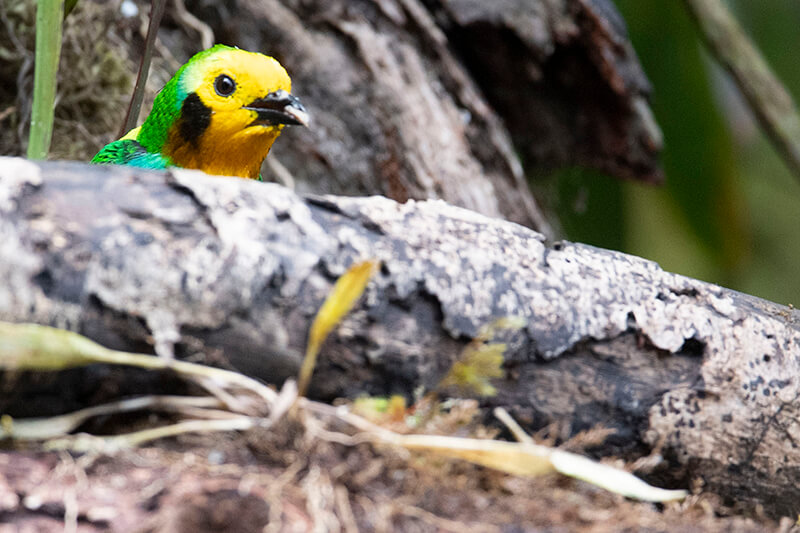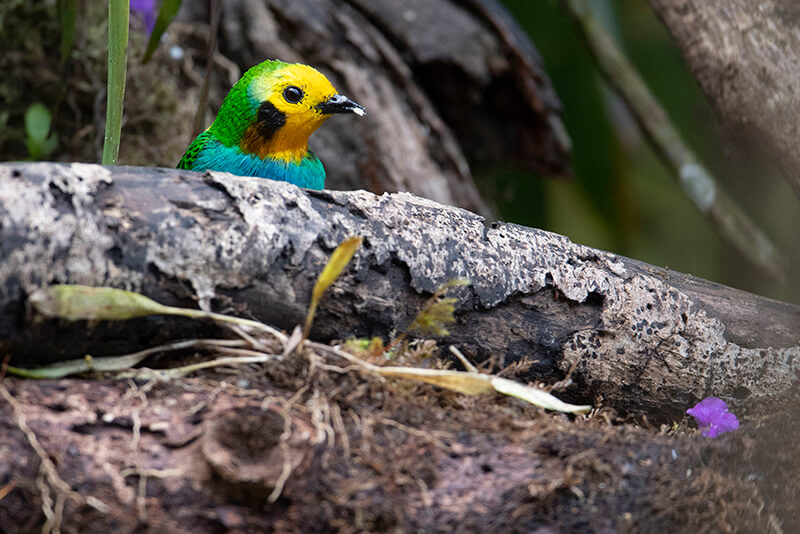MULTICOLOREd tanagER
tÁNGARA MULTICOLOR
Chlorochrysa nitidissima
This endemic tanager has a strikingly bright multicolored plumage. It measures about 12 to 13 cm and weighs between 7-22 g. It is found in the edges of humid forests and mature wet cloud foggy forests of the western and central ranges of the Andes between 1400 to 2200 m. It is an active bird with strong tarsi; and, a dark brown iris. Its head is mostly bright yellow with blue, green, gold tones. Black patches with brown borders on the ear coverts. Rear crown and nape have a green shiny color. A large orange-yellow spot in the center of throat, and on its rump. Rump shows metallic bluish-green feathers. Dorsal area near neck with a large yellow lemon patch of triangular shape. Wings have a glistening emerald green color. Upper tail coverts are bright turquoise blue with borders of blue and green color. The center of the lower breast and ventral area are black. Long and thin dark bill. Dimorphism is evident in the duller female who lacks the yellow plumage on the rump which is often difficult to observe. Feeds on insects that are under the leaves or in other parts of trees by clinging with its feet. It also feeds on fruit. It uses old abandoned nests of other species. Oval egg with brown spots on its large end. Sensible to loses of its habitat becoming a vulnerable species.
Esta tángara endémica se le conoce por su plumaje brillante y multicolor. Mide entre 12 a 13 cm y pesa entre 7 a 22 g. Se le encuentra en los pie de lomas de bosques húmedos, bosques densos y nubosos de las zonas subandinas de las cordilleras Occidental y Central entre los 1400 a 2200 m. Tarsos con patas fuertes. Iris de color café oscuro. Con corona, garganta y frente de amarillo brillante. Centro de la garganta amarillo dorado. Alas y nuca de un verde esmeralda metálico. Tiene plumas negras cortas en la región auricular. Junto a su cuello existe un área de forma triangular amarillo naranja. Parte inferior azul con mancha negra en el centro del abdomen. Pico negro, delgado y largo. Hay dimorfismo ya que el plumaje de la hembra es más opaco y carece del parche amarillo en su dorso, espalda es verde amarillenta y pecho y abdomen verde. En parejas o en bandas mixtas. Ave insectívora y frugívora. Se mantiene en los árboles donde busca su alimento. Atrapa insectos colgándose de hojas. Usa nidos viejos de otras especies. Sus huevos son ovalados con machas cafés hacia el extremo polar más grande. Es bastante sensible a la pérdida de hábitat debido a la deforestación, minería y entre otras. Su población ha disminuido ya que la mayor parte de su hábitat se ha perdido. Su estado es vulnerable.

LAM_7564

LAM_7562
